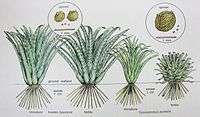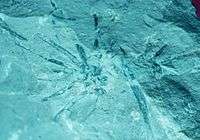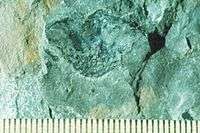Tomiostrobus
| Tomiostrobus Temporal range: Early Triassic | |
|---|---|
 | |
| Fertile plant of Tomiostrobus australis from Early Triassic Gosford Formation near Terrigal, NSW, Australia.[1] | |
| Scientific classification | |
| Kingdom: | Plantae |
| Division: | Lycopodiophyta |
| Class: | Isoetopsida |
| Order: | Isoetales |
| Family: | Isoetaceae |
| Genus: | †Tomiostrobus Retallack 1997 |
| Species | |
| |
Tomiostrobus is an extinct quillwort genus from the Early Triassic of Australia and Russia, which was especially widespread in the aftermath of Permian Triassic mass extinctions.[2]

Reconstructions of sterile and fertile examples of Isoetes beestonii from the latest Permian Coal Cliff Sandstone of South Bulli Colliery, NSW, and of Tomiostrobus australis from the Early Triassic Gosford Formation near Terrigal, NSW

Juvenile plant of Tomiostrobus australis from the Early Triassic Newport Formation near Narrabeen, NSW

Corm with root scars at base of fertile Tomiostrobus australis from the Early Triassic Gosford Formation near Terrigal, NSW
Description
Tomiostrobus australis is preserved as whole plants closely spaced within bedding planes, and lived as an early successional weed in lake and pond sedimentary environments, like living Isoetes. Unlike living Isoetes, Tomiostrobus formed closed cones with sporophylls that were distinctly shouldered and woody. This may have been an adaptation to heavy grazing by herbivorous therapsids.[1]
See also
References
- 1 2 Retallack, Gregory J. (1997). "Earliest Triassic origin of Isoetes and quillwort evolutionary radiation". Journal of Paleontology. 7 (3): 500–521.
- ↑ Retallack, Gregory J. (2013). "Permian and Triassic greenhouse crises". Gondwana Research. 24: 90–103. doi:10.1016/j.gr.2012.03.003.
This article is issued from Wikipedia - version of the 8/5/2016. The text is available under the Creative Commons Attribution/Share Alike but additional terms may apply for the media files.